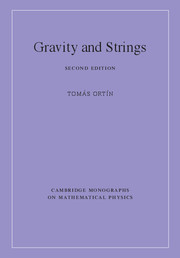Book contents
- Frontmatter
- Dedication
- Contents
- Preface to the second edition
- Preface to the first edition
- Part I Introduction to gravity and supergravity
- Part II Gravitating Point-Particles
- 11 The Schwarzschild Black Hole
- 12 The Reissner–Nordström black hole
- 13 The Taub–NUT solution
- 14 Gravitational pp-waves
- 15 The Kaluza–Klein black hole
- 16 Dilaton and dilaton/axion black holes
- 17 Unbroken supersymmetry I: supersymmetric vacua
- 18 Unbroken supersymmetry II: partially supersymmetric solutions
- 19 Supersymmetric black holes from supergravity
- Part III Gravitating extended objects of string theory
- Appendix A Lie groups, symmetric spaces, and Yang–Mills fields
- Appendix B The irreducible, non-symmetric Riemannian spaces of special holonomy
- Appendix C Miscellanea on the symplectic group
- Appendix D Gamma matrices and spinors
- Appendix E Kähler geometry
- Appendix F Special Kähler geometry
- Appendix G Quaternionic-Kähler geometry
- Appendix H Real special geometry
- Appendix I The generic scalar manifolds of N ≥ 2, d = 4 SUEGRAs
- Appendix J Gauging isometries of non-linear σ-models
- Appendix K n-spheres
- Appendix L Palatini's identity
- Appendix M Conformal rescalings
- Appendix N Connections and curvature components
- Appendix O The harmonic operator on ℝ3 × S1
- References
- Index
16 - Dilaton and dilaton/axion black holes
from Part II - Gravitating Point-Particles
Published online by Cambridge University Press: 05 April 2015
- Frontmatter
- Dedication
- Contents
- Preface to the second edition
- Preface to the first edition
- Part I Introduction to gravity and supergravity
- Part II Gravitating Point-Particles
- 11 The Schwarzschild Black Hole
- 12 The Reissner–Nordström black hole
- 13 The Taub–NUT solution
- 14 Gravitational pp-waves
- 15 The Kaluza–Klein black hole
- 16 Dilaton and dilaton/axion black holes
- 17 Unbroken supersymmetry I: supersymmetric vacua
- 18 Unbroken supersymmetry II: partially supersymmetric solutions
- 19 Supersymmetric black holes from supergravity
- Part III Gravitating extended objects of string theory
- Appendix A Lie groups, symmetric spaces, and Yang–Mills fields
- Appendix B The irreducible, non-symmetric Riemannian spaces of special holonomy
- Appendix C Miscellanea on the symplectic group
- Appendix D Gamma matrices and spinors
- Appendix E Kähler geometry
- Appendix F Special Kähler geometry
- Appendix G Quaternionic-Kähler geometry
- Appendix H Real special geometry
- Appendix I The generic scalar manifolds of N ≥ 2, d = 4 SUEGRAs
- Appendix J Gauging isometries of non-linear σ-models
- Appendix K n-spheres
- Appendix L Palatini's identity
- Appendix M Conformal rescalings
- Appendix N Connections and curvature components
- Appendix O The harmonic operator on ℝ3 × S1
- References
- Index
Summary
In Chapter 15 we have seen how scalar fields coupled to gravity arise naturally in KK compactification. In Part III we are going to see that scalar fields are also present, even before compactification, in some higher-dimensional supergravity theories that are the low-energy effective field theories of certain superstring theories. In all these examples the scalar fields couple in a characteristic way to vector (or p-form in higher dimensions) field strengths. In this chapter we are going to study first, in Section 16.1, a simple model that synthesizes the main features of those theories.
The a-model describes a real scalar coupled to gravity and to a vector field strength. The coupling is exponential and depends on a parameter a (hence the name “a-model” that we are giving it here). Since the scalar can be identified in some cases with the string dilaton (or with the KK scalar, which is also called the dilaton sometimes), these models are also generically referred to as dilaton gravity. We will be able to obtain BH-type solutions for general values of a and in any dimension d ≥ 4; however, only a handful of values of a actually occur in the theories of interest, although they occur in many different ways (embeddings [854]).
After studying the main properties of these dilaton BHs, we are going to study in Section 26.1 a more complex (four-dimensional) model that involves several scalar and vector fields. We are going to obtain extreme BH solutions that can be understood as composite BHs. This interpretation will open the door to the construction of four-dimensional extreme BH solutions in string theory as composite objects, the building blocks being p-branes and other extended objects that we will study in Chapter 26.
In Section 16.2 we add to the a-model with a = 1 and d = 4 a second scalar that couples not to the vector field kinetic term F2 but to F ⋆ F and also couples to the dilaton.
- Type
- Chapter
- Information
- Gravity and Strings , pp. 464 - 483Publisher: Cambridge University PressPrint publication year: 2015



